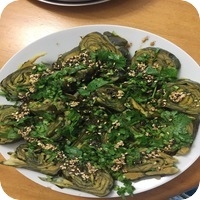Satvik Food

A Good habit for a healthy life
Food plays a vital role in the existence and regeneration of humans.
The sloka recited by Lord Sri Krishna In Bhagavad Gita Chapter 6 Verse 17
“Those who are moderate in eating and recreation, balanced in work and regulated in sleep, can mitigate all material sorrows through Yogic practices”
- Ahara niyamam (Regulated food intake) by acharya Swami Vedanta Desikan encompasses a holistic approach to dietary habits, integrating physical, mental, and spiritual dimensions.
yuktha:ha:ra viha:rasya yuktha che:stasya karmasu yuktha swapna:vabo:dhasya yo:go: bhavathi dukha ha:
Based on these categories some of the food that is recommended
Based on these categories some of the food that is recommended to avoid according to Ahara Niyamam over and above following a vegetarian diet are Sorrel leaves (Gongura), Mushrooms, Onions, Garlic, Ridge gourd, Bottle gourd, Radish, Drumsticks and Eggs.
- Tamasic foods, on the other hand, are regarded as detrimental to both physical and spiritual well-being and are best avoided.
- By making mindful dietary choices aligned with these principles, individuals seek to cultivate physical health, mental clarity, and spiritual growth.
Purity and Avoidance of Impurities
Ahara niyamam emphasizes the importance of consuming pure and untainted food. This involves avoiding foods that are considered impure or detrimental to one’s physical and mental well-being, such as meat, fish, and intoxicants. By abstaining from such impurities, individuals aim to maintain a clean and healthy body, which is seen as a prerequisite for spiritual growth.
Sattvic Diet:
Central to Ahara niyamam is the concept of a sattvic diet. Sattva refers to purity, harmony, and balance. A sattvic diet consists of foods that are fresh, nutritious, and conducive to maintaining mental clarity and emotional equilibrium. This includes fruits, vegetables, grains, nuts, and dairy products. By nourishing the body with sattvic foods, individuals seek to cultivate positive qualities such as tranquility, compassion, and spiritual awareness.
Moderation and Balance
Ahara niyamam advocates for moderation and balance in eating habits. Overindulgence or excessive consumption is discouraged, as it can lead to physical discomfort, lethargy, and distraction from spiritual pursuits. Instead, individuals are encouraged to eat mindfully, savoring each morsel and being aware of their body’s hunger and satiety cues. By maintaining a balanced approach to food, individuals strive to cultivate self-discipline and restraint.
Gratitude and Reverence
Ahara niyamam fosters a sense of gratitude and reverence towards the divine for providing sustenance. Before consuming food, individuals may offer prayers or express gratitude for the blessings of nourishment. This practice not only acknowledges the interconnectedness of all beings but also instills a sense of humility and appreciation for the abundance provided by the divine.

 Ra:jasamu / Ra:jas
Ra:jasamu / Ra:jas
Sattvic foods are considered pure, wholesome, and conducive to spiritual growth. They promote clarity of mind, harmony, and balance within the body. Sattvic foods are typically fresh, light, and easily digestible. Examples include fruits, vegetables, grains, nuts, seeds, dairy products, and natural sweeteners. Consuming sattvic foods is believed to foster virtues such as compassion, tranquility, and spiritual awareness.
 JSa:thvikamu / Sa:thvik:
JSa:thvikamu / Sa:thvik:
Sattvic foods are considered pure, wholesome, and conducive to spiritual growth. They promote clarity of mind, harmony, and balance within the body. Sattvic foods are typically fresh, light, and easily digestible. Examples include fruits, vegetables, grains, nuts, seeds, dairy products, and natural sweeteners. Consuming sattvic foods is believed to foster virtues such as compassion, tranquility, and spiritual awareness.


 Tamasic foods are considered heavy,
Tamasic foods are considered heavy,
dulling, and detrimental to both physical and spiritual well-being. They are often devoid of nutritional value and may be difficult to digest. Tamasic foods can induce lethargy, inertia, and cloudiness of the mind. Examples include stale or spoiled foods, meat, fish, alcohol, and heavily processed or refined foods. Consumption of tamasic foods is discouraged in Srivaishnava philosophy, as they are believed to obstruct spiritual growth and lead to negative emotions and behaviors.
Sa:thvikamu / Sa:thvik

 Ra:jasamu / Ra:jas
Ra:jasamu / Ra:jas
Sattvic foods are considered pure, wholesome, and conducive to spiritual growth. They promote clarity of mind, harmony, and balance within the body. Sattvic foods are typically fresh, light, and easily digestible. Examples include fruits, vegetables, grains, nuts, seeds, dairy products, and natural sweeteners. Consuming sattvic foods is believed to foster virtues such as compassion, tranquility, and spiritual awareness.
Ra:jasamu / Ra:jas

 JSa:thvikamu / Sa:thvik:
JSa:thvikamu / Sa:thvik:
Sattvic foods are considered pure, wholesome, and conducive to spiritual growth. They promote clarity of mind, harmony, and balance within the body. Sattvic foods are typically fresh, light, and easily digestible. Examples include fruits, vegetables, grains, nuts, seeds, dairy products, and natural sweeteners. Consuming sattvic foods is believed to foster virtues such as compassion, tranquility, and spiritual awareness.
Ta:masamu / Ta:mas



